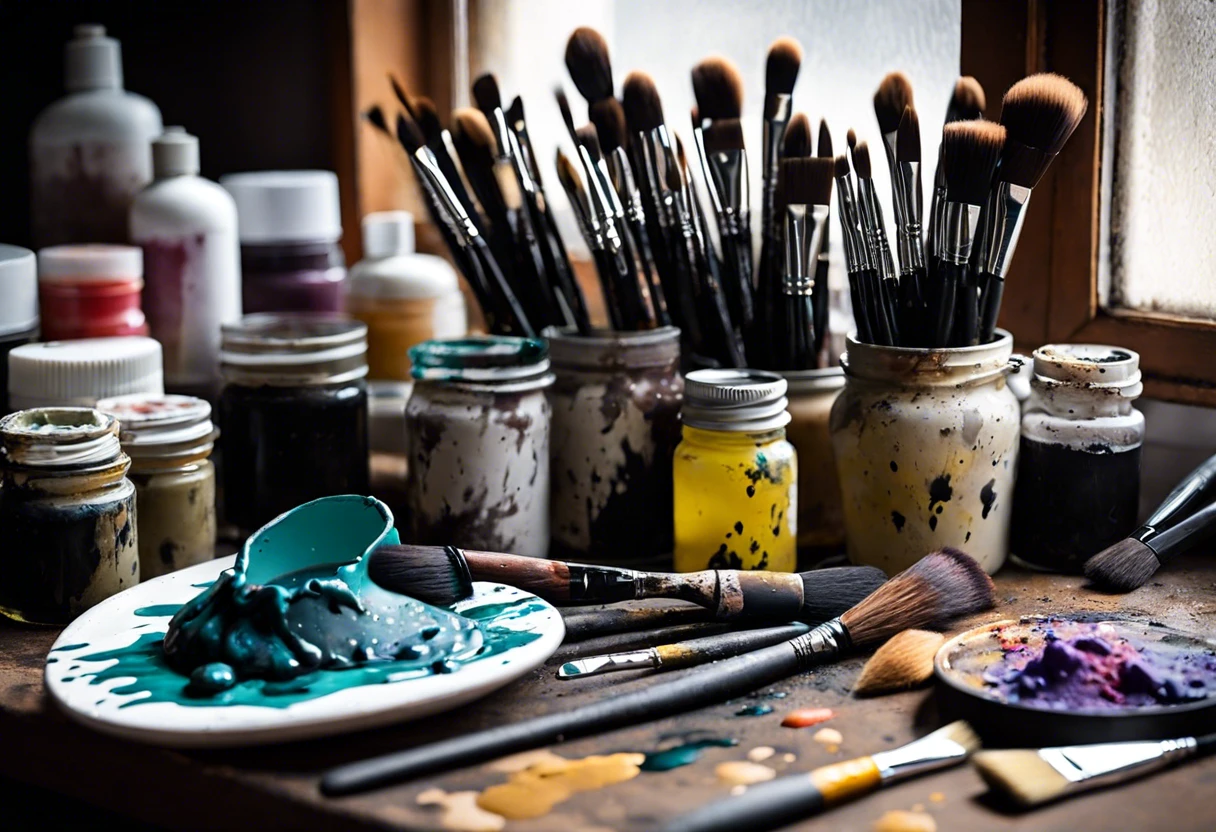How to Clean Dried Acrylic Paint From Brushes?
Published on: February 28, 2025 | Last Updated: January 7, 2025
Written By: Alisha Winters
Brushes are tools we use to paint, drawing beautiful colors on paper or canvas. Imagine a magic wand that spreads colors just like fairy dust!
Learning how to clean dried acrylic paint from brushes is super important. I once ruined a favorite brush because I didn’t clean it right away, and I’d hate for you to face the same fate.
In this article, you’ll find preparation steps before cleaning your brushes, methods to effectively remove dried paint, caring for different types of brushes, and tips to tackle common issues. You’ll also discover how to clean hard or old paint brushes, and even learn about DIY projects to practice your skills!
Contents
- 1 How to Clean Dried Acrylic Paint From Brushes?
- 2 What Are Brushes?
- 3 Preparation Steps Before You Start Cleaning Your Brushes
- 4 Steps to Effectively Remove Dried Acrylic Paint From Brushes
- 5 Types Of Brushes for Cleaning Dried Acrylic Paint
- 6 Factors Affecting the Effectiveness Of Brush Cleaning
- 7 Common Issues When Cleaning Dried Acrylic Paint From Brushes
- 8 Cleaning Alternatives: Effective Solutions for Dried Acrylic Paint
- 9 Time-Saving Tips for Cleaning Brushes
- 10 Best Practices for Maintaining Your Brushes
- 11 Quick Reference for Brush Types and Uses
- 12 Finishing Touches: Caring for Your Brushes Post-cleaning
- 13 Frequently Asked Questions (FAQs)
- 14 Conclusion
- 15 Additional Resources
How to Clean Dried Acrylic Paint From Brushes?
To clean dried acrylic paint from brushes, soak them in warm water for about 20 minutes. Use a brush comb or your fingers to gently work the paint out. Rinse thoroughly with clean water. Repeat if needed! If you’re experiencing persistent paint issues, you might want to explore common paint adhesion problems.
The Finishing Touch
A freshly painted wall is a blank canvas. The best way to bring your room to life is with a single piece of statement art that ties everything together.
Browse Wall Art at Big Wall DecorWhat Are Brushes?
Brushes are essential tools in art. They come in various shapes, sizes, and materials, optimized for different mediums like acrylic, oil, or watercolor. Most brushes are categorized by bristle types, including natural hair, synthetic fibers, or a blend of both, offering a range of textures and techniques. A standard paintbrush can range from 0.5 to 5 cm (0.2 To 2 Inches) in width, giving artists control from fine details to broad strokes.
Now, onto the practical stuff. When dried acrylic paint clumps on your brush, cleaning becomes a hassle. I once spent hours fighting a stubborn set of brushes covered in paint; I realized I needed an effective cleaning method! If you’re looking to restore your painting tools and techniques, check out some professional paint restoration strategies.
Once, while working on a detailed portrait, I discovered my brush had seen better days due to dried acrylic paint. This experience taught me the importance of routine cleaning after each session. Knowing how to remove dried acrylic paint from brushes is crucial. Trust me, keeping your tools maintained—like using soap and water—can significantly improve your craftsmanship and enhance your next canvas!
Preparation Steps Before You Start Cleaning Your Brushes
What do you need to prepare for?
- Cleaning Solution: Use a cleaning solution like Winsor & Newton Brush Cleaner, which effectively breaks down dried acrylic paint and softens bristles.
- Container: You’ll need a plastic container with at least 500 mL (17 Fl Oz) capacity to hold the cleaning solution for soaking your brushes.
- Paper Towels: Grab quality absorbent paper towels, such as Bounty, for wiping excess paint and cleaning brushes easily.
- Hair Comb: A fine-toothed hair comb helps remove dried paint from bristles without damaging them, especially for large flat brushes.
We’ve wrapped up essential preparation steps for cleaning brushes. Let us turn our attention to effectively removing dried acrylic paint.
Also See: Can Behr Paint Match Sherwin Williams? Yes!

Steps to Effectively Remove Dried Acrylic Paint From Brushes
Here are the steps to get dried acrylic paint out of your brushes.
The Finishing Touch
A freshly painted wall is a blank canvas. The best way to bring your room to life is with a single piece of statement art that ties everything together.
Browse Wall Art at Big Wall Decor-
Soak the Brushes in Water or Solvent
Start by submerging your dried brushes in warm water (About 40°C or 104°F) for 10-15 minutes. If the paint’s really stubborn, try paint thinner; it often contains solvents that break down paint quickly. Professional painters have unique techniques for resolving tricky paint challenges.
Check the consistency after soaking. You might need to repeat the soaking, especially for thicker layers. Time matters, so don’t rush this step!
-
Gently Remove Dried Paint
Next, use your fingers or a tool like a palette knife or scraper to gently push the paint off the bristles. Be gentle—too much force could damage the brush.
I’ve found that an old toothbrush can help with stubborn sections. Just be careful not to bend the bristles too much.
-
Wash the Brushes Thoroughly
After removing most of the paint, wash the brushes with soap and lukewarm water. Dish soap usually cuts through residue well; use a gentle touch to avoid damage.
A quick rinse followed by soapy water works wonders! Rinse until the water runs clear.
-
Reshape and Dry the Brushes
After washing, reshape the bristles to their original form. Let them hang or lay flat to avoid bending while they dry.
Remember, drying time varies with humidity. Ideally, if you leave them overnight, they’ll be ready for your next project!
We’ve wrapped up effective methods to remove dried acrylic paint from brushes here. Let us turn our attention to types of brushes for cleaning.
Types Of Brushes for Cleaning Dried Acrylic Paint
Let’s discuss the brushes you’ll use for cleaning dried acrylic paint. We’ll cover synthetic, natural hair, fan, and stencil brushes.
-
Synthetic Brushes
Synthetic brushes are made from nylon or polyester fibers. They hold water and paint well, making them ideal for quickly cleaning dried acrylics.
-
Natural Hair Brushes
Natural hair brushes use animal hair, such as sable or squirrel. They’re soft but can trap moisture, requiring careful maintenance to remove dried paint.
-
Fan Brushes
Fan brushes have a unique shape that helps reach tricky spots. Their bristles easily scrub away chunks of dried paint while preserving the brush’s shape.
-
Stencil Brushes
Stencil brushes have short, stiff bristles that are excellent for scrubbing. They’re perfect for tackling tough, dried acrylic paint without damaging the bristles.
In my experience, synthetic brushes are my go-to for cleaning. They’re durable and effectively remove stubborn, dried acrylic paint.
You should now have a good understanding of different brush types for cleaning dried acrylic paint. In the next part, we’ll discuss factors that influence brush cleaning effectiveness.
Factors Affecting the Effectiveness Of Brush Cleaning
What factors influence the success rate of cleaning brushes with dried acrylic paint?
-
Type of Solvent: The cleaner you use, whether water or a specialized thinner, greatly impacts how easily the paint comes off.
-
Application Duration: Brushes left with dried paint for longer are harder to clean, so don’t procrastinate!
-
Brush Material: Synthetic brushes react differently to cleaners than natural bristles, affecting cleaning ease.
-
Temperature and Humidity: Warmer, more humid environments can soften dried paint, making removal easier.
So far we covered the elements influencing brush cleaning efficiency. Let’s look at common problems encountered when removing dried acrylic paint from brushes next.

Common Issues When Cleaning Dried Acrylic Paint From Brushes
Once, my friend tried to clean a brush after leaving it covered for days. The dried acrylic clumped, making it tough to salvage. Basic soap and water just wouldn’t work.
To tackle this job, soak the brush in rubbing alcohol (Isopropyl) for 10 minutes, then gently comb through the bristles. This should help you reuse those brushes easily!
Cleaning Alternatives: Effective Solutions for Dried Acrylic Paint
Sometimes, you need extra help when cleaning dried acrylic paint from brushes. Here are some proven alternatives to traditional methods.
-
Vinegar and Water Combination
Mix equal parts white vinegar and warm water. Soak your brushes for about 30 minutes to break down the paint. Vinegar’s acid works wonders!
-
Baking Soda Paste
Create a paste using baking soda and a bit of water. Rub it onto the bristles and let it sit for about 10 minutes. Rinse thoroughly. It’s cheap and effective!
-
Olive Oil Treatment
Soak the brushes in olive oil for 15 minutes to help loosen dried paint. The oil penetrates and softens the paint without damaging the bristles.
Time-Saving Tips for Cleaning Brushes
Short on time? Here are some quick tips to efficiently clean your brushes!
| Method | Time Required | Effectiveness |
|---|---|---|
| Soaking in Water | 10-20 minutes | Good for softening paint |
| Using Alcohol | 5-10 minutes | Excellent for stubborn paint |
| Quick Rinse Method | 2-5 minutes | Ideal for freshly used brushes |
| Baking Soda Paste | 10 minutes | Good for caked-on paint |
Best Practices for Maintaining Your Brushes
Keeping your brushes in top shape extends their life and maintains performance.
The Finishing Touch
A freshly painted wall is a blank canvas. The best way to bring your room to life is with a single piece of statement art that ties everything together.
Browse Wall Art at Big Wall Decor- Always Rinse After Use: Don’t wait! Rinse your brushes in warm water immediately after use. This simple step prevents paint from drying.
- Store Properly: Store brushes upright in a holder or lay them flat. Avoid cramming them in a drawer—this can cause bristles to bend.
- Condition Regularly: Use a brush conditioner regularly. It nourishes the bristles, keeping them soft and flexible—just like your hair needs conditioner!
Quick Reference for Brush Types and Uses
Different brushes serve different purposes in art; here’s a quick guide.
- Round Brushes: Great for detailed work. Ideal for fine lines.
- Flat Brushes: Perfect for bold strokes and filling wide areas.
- Filbert Brushes: Combine features of round and flat brushes; great for blending.
- Detail Brushes: Excellent for intricate details and precision work.
Finishing Touches: Caring for Your Brushes Post-cleaning
After cleaning your brushes, condition the bristles with a quality brush soap like Masters Brush Cleaner. Squeeze out excess moisture and reshape the bristles to maintain their form.
Inspect your brushes for split hairs and damaged ferrules. Use a magnifying glass to check for misaligned fibers—about 5% can hinder your next masterpiece.
I recommend using Golden Artist Colors’ Brush Restorer to keep your brushes pristine. Three small drops work wonders, restoring flexibility and cleaning power effectively.
For advanced artists, consider a brush management system that catalogs performance—track paint types with electronic labels for each brush at 200 µm (Micrometers) precision.
Frequently Asked Questions (FAQs)
What Solvents Are Effective for Cleaning Dried Acrylic Paint?
Yes, many solvents are effective for cleaning dried acrylic paint from brushes. Common choices include isopropyl alcohol (IPA) and acetone, which break down the acrylic compounds effectively. IPA is around 70% effective, while acetone can reach 100% but may damage some brush bristles if used frequently.
Can I Use Dish Soap to Clean My Brushes?
Yes, you can use dish soap to clean your brushes. Dish soap helps to break down grease and residues, which is essential when cleaning acrylic paint. It’s cost-effective, and a small amount mixed with warm water can go a long way in removing paint. If you’re working with pumpkins for a creative project, you might want to explore acrylic painting techniques for your seasonal artwork.
How Often Should I Clean My Brushes?
You should clean your brushes after each art session. Cleaning regularly prevents paint from drying, which maintains the brush’s quality. A study shows that brushes cleaned immediately last 2-3 times longer than those left uncleaned.
What Happens if I Let the Paint Dry Completely on the Brushes?
If you let the paint dry completely on the brushes, it can ruin the bristles. Dried paint makes brushes stiff and unusable. In some cases, you might need to replace the brush, which can range from $5 to $50 depending on the size and quality. When painting apartment walls, proper brush maintenance becomes crucial to avoid unnecessary expenses and protect your painting investment.
Is It Okay to Reuse Dirty Brushes for Different Colors?
No, it’s not okay to reuse dirty brushes for different colors. Using dirty brushes can muddy your artwork and lead to unwanted color mixing. It’s always best to clean your brushes before switching colors to maintain clean lines and vibrant hues.
How Can I Best Dry My Paint Brushes After Cleaning?
The best way to dry your paint brushes after cleaning is to lay them flat on a clean towel. This prevents water from settling into the ferrule, which can loosen the bristles. For optimal results, let them dry horizontally for at least an hour. If you’re working on creative projects like customizing shoes, you might want to explore painting techniques for footwear.
Can I Wash My Brushes in Hot Water?
Generally, you should avoid washing your brushes in hot water. High temperatures can damage fragile bristles and loosen their glue. Cold to lukewarm water works best to maintain your brushes, ensuring longevity and resilience.
What’s the Best Tool for Scrubbing Dried Paint Off My Brushes?
A brush cleaner or a brush comb is the best tool for scrubbing dried paint off your brushes. These tools gently remove debris without damaging bristles. They’re often inexpensive, costing around $5 to $15, but they can extend your brush life significantly. If you’re working with acrylic paints, knowing the right cleaning techniques can help preserve your painting tools’ quality and performance for acrylic painting success.
How Can I Restore an Old Paint Brush?
You can restore an old paint brush by soaking the bristles in a mix of vinegar and water. This soak helps to rehydrate stiff bristles and remove old paint. Soaking for 30 minutes to an hour does the trick, making your brush viable again. If you’re curious about alternative paint applications, check out how to use acrylic paint safely.
Conclusion
You made it to the end. We covered how to clean dried acrylic paint from painting techniques and tools, preparation steps, effective removal techniques, types of brushes, and common issues that arise when cleaning. We also touched on caring for your brushes afterward and even some DIY projects to practice your skills.
Hopefully, I was able to impart some of my experience on cleaning dried acrylic paint from brushes. It’s all about the right steps and tools. Use warm soapy water, a brush cleaner, or some paint thinner, and remember to rinse thoroughly for great results.
If you found this information helpful, be sure to explore more of what Paint Answers has in store for you.
Additional Resources
- Smith, R. (2003). The Artist’s Handbook of Materials and Techniques (5th ed.). New York, NY: Knopf.
- How to Clean Acrylic Paint Brushes | Bromleys Art Supplies
- Cleaning acrylic paint brushes – the MRH Forum
Experienced interior designer with 15+ years in transforming spaces, blending artistry with expertise in color and design. Rhode Island School of Design graduate, specializing in restorations and modern makeovers.
Cleaning, Topics









